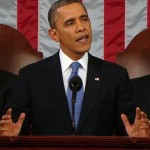 [1]
[1]As expected, President Obama primarily discussed jobs and gun control in his 2013 State of the Union address [2], though he also made some interesting higher-ed proposals as well.
Early in his speech, Obama took a moment to address how the looming sequestration [3]—or across-the-board cuts of about 7.5 percent to domestic programs—will devastate priorities like medical research and education, and he spoke of the need for bipartisanship to avoid the first round of cuts expected to hit on March 1.
The original sequestration was supposed to take effect Jan. 2 but was delayed two months as a result of the 11th-hour American Taxpayer Relief Act of 2012 [4] that was passed Dec. 31.
Obama proposed that Congress change the Higher Education Act [5](HEA), which is due for revision this year, and add greater stipulations that determine which colleges receive certain types of federal aid based on their affordability and value.
“Through tax credits, grants, and better loans, we have made college more affordable for millions of students and families over the last few years,” said Obama. “But taxpayers cannot continue to subsidize the soaring cost of higher education. Colleges must do their part to keep costs down, and it’s our job to make sure they do.”
(Next page: Details about Obama’s “College Scorecard”)
The administration has actively expressed its desire to restore the United States to first in the world in college attainment by 2020. “Race to the Top” [6] is one such pathway program that encourages states to develop more rigorous high school curricula, so that more students succeed and move on to college.
Obama promoted the soon-to-be-released “College Scorecard,” [7] an idea that has been floated by politicians in the past, which will help students and parents determine which colleges will deliver the most bang for their educational buck. The “College Scorecard” will be an online, interactive tool and is the next step in the administration’s “Race to the Top” initiative.
Through “College Scorecard,” students will be able to enter their individual needs—including the degree or major they are seeking, and the location and size of their desired school—to determine which school is the right fit for them. Each scorecard includes a college’s cost, graduation rate, loan default rate, average amount borrowed, and employment numbers. The Education Department plans to update these scorecards periodically to ensure the data are current.
“We know students and families are often overwhelmed in the college search process—but feel they lack the tools to sort through the information and decide which school is right for them,” said Education Secretary Arne Duncan in a statement. “The College Scorecard provides a snapshot about an institution’s cost and value to help families make smart decisions about where to enroll.”
Obama made higher education a priority [8] in his first term, enacting a “Pay As You Earn” [9] plan that allows students to cap their monthly student loan payments to 10 percent of their monthly income. His administration raised the maximum Pell Grant amount to $5,635 for the 2013-14 award year, and Pell recipients have expanded by 50 percent since he first took office in 2008.
“Skyrocketing costs price way too many young people out of a higher education, or saddle them with unsustainable debt,” he said.
Obama hopes to reverse the evident downturn of students pursuing science, technology, engineering, and mathematics (STEM) jobs by offering high schools incentives for focusing on STEM courses.
“We’ll reward schools that develop new partnerships with colleges and employers, and create classes that focus on science, technology, engineering, and math—the skills today’s employers are looking for to fill jobs right now and in the future,” he said.
Obama echoed his long-held belief that proper training and expanded educational access is the best pathway to improve the workforce, and to strengthen the economy as a whole.
“To grow our middle class, our citizens must have access to the education and training that today’s jobs require,” he said. “But we also have to make sure that America remains a place where everyone who’s willing to work hard has the chance to get ahead.”
Follow Assistant Editor Sarah Langmead on Twitter at @eCN_Sarah [10].